The Native gardenia is the kind of shrub or tree that is rather generous in its natural bounty. If you could choose any plant, shrub or tree for your garden, wouldn’t you favour something that has beautiful fragrant flowers, delicious fruit, and can provide shade?
In this guide, we look at the features of the native gardenia, how to care for it, how to propagate from seeds and cuttings, pests and diseases to watch for, and also some info about yellow mangosteen as bush tucker.
More...
Genus: | Atractocarpus |
|---|---|
Species: | A. fitzalanii |
Family: | Rubiaceae |
Common Names: | Native Gardenia, Yellow Mangosteen |
Sunlight: | full sun to part shade |
Soil: | moist and well drained |
Height: | up to 8 metres |
Spread: | up to 4 metres |
Growth rate: | medium |
Foliage: | medium green and glossy |
Flowers: | white and star shaped |
Flowering: | spring |
Introducing the Native Gardenia
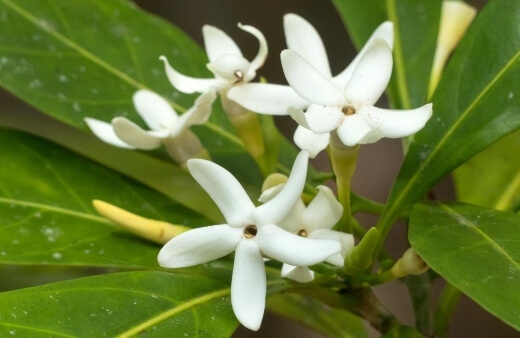
The native gardenia, also known as yellow mangosteen, is thought of as a good bush tucker and was used in Aboriginal cuisine. It’s quite a common plant found in coastal forests and beach areas from far North Queensland down through Mackay.
The plant produces hard-shelled fruits which have a pale, soft and sweet segmented fruit with many small white seeds. They are in fact similar to a mangosteen in size, shape and flavour. The yellow mangosteen fruit can be eaten raw or used in salads, cakes and other desserts.
In springtime, the native gardenia produces white, beautifully fragrant, star-shaped flowers. The flowers later turn into brown fruit that ripens slowly over winter, and then turns yellow when ready for harvesting.
If the native gardenia is left to grow as a tree, it can reach a height of up to 8 metres and even provide some shade. If you commit to regular pruning, you can keep your native gardenia in a pot or at shrub size.
It makes a wonderful display plant and can be used in tropical gardens and for feature planting, anywhere you can enjoy the beautiful scent.
The native gardenia will do best in a partly shaded position in your garden and prefers warm, moist conditions. You can grow it as far south as Sydney.
Native gardenias are shrubs or small trees that can grow 4 – 8 metres tall. They have open branches and can spread up to 4 metres wide. They have dark green glossy leaves and plenty of perfumed small white flowers in spring. The lovely flowers attract bees.
The flowers are then followed by large yellow fruit, up to 10 cm in diameter. They look similar to apples and you can eat them when soft. The fruit ripens in winter and has whitish small seeds.
The leaves are lovely, making the native gardenia a popular small to medium shade tree.
How to Grow Native Gardenia
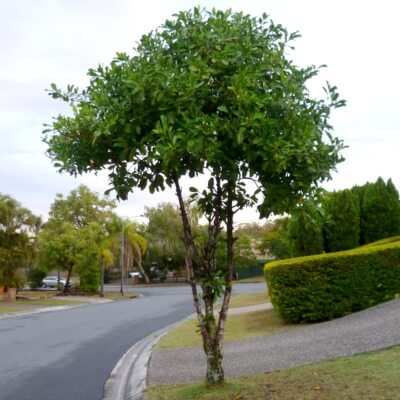
Source: calyx.com.au
Propagation of Native Gardenia
How to Propagate Yellow Mangosteen from Seed
Native gardenia seed can be sown most of the year but is generally best sown in spring or autumn. You want to avoid the coldest and hottest months of the year. The best temperature for germination is between 20-25°C.
You want to sow the seed on a porous seed raising mixture and then cover lightly. Place the container in a warm shaded or semi shaded area so it doesn’t dry out.


Get Your Free Guide:
Master Growing Australian Natives eBook
A Must Have Complete Guide for Every Australian Garden
Get Your Free Guide:
Master Growing Australian Natives eBook
A Must Have Complete Guide for Every Australian Garden
The growing medium needs to be well-draining but needs to remain damp between watering. The trick here is to keep it moist but not too wet otherwise the seed may rot.
Do not let the growing mix completely dry out. Germination usually happens in 28-56 days depending on the temperature and conditions. It’s worth keeping seed that does not germinate straight away.
Seeds will sometimes be dormant until the conditions are closer to what they need for germination to occur. Containers put aside for a while might reveal some sprouts eventually.

Source: domusnursery.com.au
Atractocarpus fitzalanii Propagation from Cuttings
When selecting your cutting, it should be at least 12.5 cm long and taken from the tip of the branch. You’re aiming for softwood or green wood cutting. The next step is to remove the lower leaves.
Take all the leaves off the cutting except for the top two sets. Prepare a pot by filling it with equal parts of peat or potting soil and sand and wet the peat/sand mixture.
Dip the cut end of the native gardenia cutting into a rooting hormone. Create a hole in the mixture and place the cutting in the hole and then backfill. Place the cutting in bright but indirect light and try to keep the temperature around 24°C. The peat or sand mixture needs to stay damp but not soaked.
The key to propagating native gardenias successfully is making sure the cuttings stay in high humidity until they root. The easiest way to do this is to cover the pot with a clear plastic bag which creates a greenhouse effect.
Just don’t allow the cover to touch the cutting. Regular misting sessions also help the native gardenia to thrive and grow. The plant should be rooted in four to eight weeks. Propagating native gardenias from cuttings is a great way to use up leftover trimmings from pruning.
No matter how long you’ve been gardening, you can always use some tips and advice. We’ve got a collection of gardening tips to support every gardener, from the beginner, to the green thumb expert.
Check out our tips on everything from soil care to landscaping and everything in-between.
Native Gardenia Care Guide

Source: monaconatureencyclopedia.com
Fertilising Yellow Mangosteen
Native gardenias are heavy feeders and like lots of iron and magnesium. You can feed your plant every 2 to 3 months from spring to autumn with a dose of cow manure or an organic fertiliser if you don’t have great soil.
For healthy growth and large flowers we also recommend fortnightly feeding with something like seaweed extract. You’ll get amazing results with regular liquid feeding.
Pruning Native Gardenia
Native gardenias that are grown in enough light will naturally produce a good shape and not need pruning. They can be pruned if you need to reduce their height or keep a certain shape.
You can prune after a rush of flowers, anytime from late summer into autumn. If you live somewhere with a warm climate, pruning can also be done in winter.
Soil and Watering for Yellow Mangosteen
Atractocarpus fitzalanii needs a humus rich and moist yet well drained soil. You want to maintain a soil pH of 6-7 for your native gardenia and keep the plant well mulched around the root zone to ensure the soil stays moist and cool.
This plant needs deep, regular watering and might need additional water through dry summer seasons.
Climate and Sunlight Needs
Native gardenias like a tropical, rainforest environment but they can handle warm temperate conditions if they’re in a sheltered and moist position.
Native gardenias like full sun or part shade and can also be grown in containers. Be sure to protect your plant from strong winds.
Native Gardenia as Bush Tucker
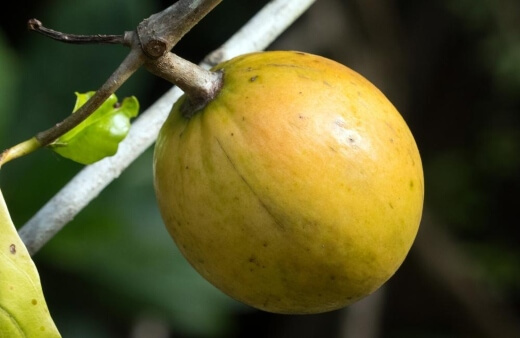
Native gardenia fruit can be eaten raw. It can also be used in salads, tarts, jams, cakes and other desserts. The fruit isn’t overly sweet on its own (it has high acidity), but is great when combined with other foods or ingredients and adds a unique richness.
The actual taste of the fruit varies. Different plants will have different tasting fruit. Fruit that has come from a good native gardenia variety will be large with small seeds, and will taste sweet. The rind is inedible.
The fruit of the Atractocarpus fitzalanii can be deceiving and tricky to know when it’s ripe. It can be tempting to pick off large, round yellow fruit, thinking it will be perfect and juicy.
You actually need to go for the shrivelled, brown fruits to make the most of the soft flesh inside. When you open a ripe native gardenia, you will see fruit with a thick, brown flesh.
Yellow mangosteens must not be frozen. Refrigeration or freezing quickly causes damage to the fruit. For longer storage, keep it at 10°C which will make it last for several weeks.
If you want to impress your friends with your knowledge of Australian Bush Tucker, why not have a look at our collection of articles. We cover everything from native greens, vegetables and herbs, to medicinal bush tucker.
Native gardenia Pests and Diseases to Look Out For
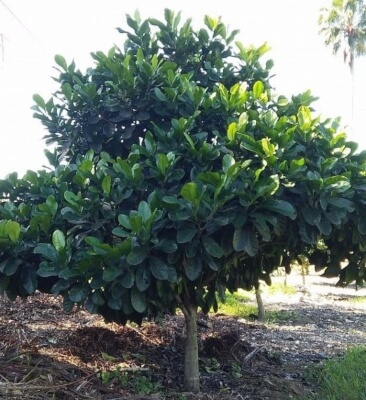
Source: gympielandcare.org.au
Yellow or pale leaves is a common problem with Atractocarpus fitzalanii. Here are a few reasons why it might happen:
Cold weather – these warm climate plants respond to winter and early spring weather by pulling nutrients out of their older leaves and then dropping them.
Old leaves – leaves have a brief lifespan and yellow mangosteens tend to release old ones together. If you see a whole lot of yellow leaves low on the branches but the rest of the growth is green, your plant is probably doing a shedding.
Incorrect soil pH – native gardenias like acidic soils. If they grow in alkaline soils they can’t access all the nutrients they need which causes the yellow leaves. You can apply sulphur to the soil to make it more acidic.
Lack of nutrients – if the soil pH is acidic but the native gardenia still looks pale or yellow all over then the plant might just be hungry. These plants are considered heavy feeders and a lack of nutrition shows quickly.
Specific nutrient deficiency – yellow mangosteens might be lacking a particular nutrient which shows up as yellow/pale leaves with certain patterns. The most common ones are:
- magnesium – pale/yellow triangular pattern with leaf tips and edges
- iron – pale/yellow leaves but the veins are green
- nitrogen – new growth is pale/yellow
You can treat the plant for the specific deficiency, like using epsom salts for magnesium, but it’s best to first check the soil pH is acidic and then feed with a complete nutrient source. We recommend some cow manure or an organic fertiliser.
Other than yellowing leaves, there are a few pests to look out for Aphids, scale and mites suck nutrients from the plant and you can spray with neem oil to keep it at bay.
Neem oil kills a wide variety of insects that might affect your native gardenia including aphids, mealybugs, caterpillars, and other garden pests like spider mites.
Sooty mould is a secondary problem caused by sap sucking pests like aphids and scale. Once you manage the pests the sooty mould will dry up and flake away.
If you notice lots of ants on your plant then it means you’re dealing with aphids or mealybug and the ants are feeding on their sugary excretions. If you control the pests, the ants will go away. You can help the process by applying a border of horticultural glue around the base of plant trunks to limit their movements.
If you start to notice bud drops or flowers failing to open, it’s usually a sign that your plant is stressed. Some bud fall is normal in spring but often your plant is too dry or too wet. You can adjust your watering accordingly. The bud drop can also be caused by pests feeding at the base of the bud and often mealybug is the main culprit.
Native Gardenia FAQs

Source: en.wikipedia.org
Where does Atractocarpus fitzalanii get its name?
The genus name is derived from the Greek words 'atractos' meaning spindle and 'karpos' meaning fruit due to the spindle-shaped fruit of the first recorded species.
Fitzalanii was named by Victorian State Botanist Ferdinand von Mueller, who named it in honour of the person who first collected it, Eugene Fitzalan. He was a botanist who created the first botanical garden in Cairns.
Are yellow mangosteens good for you?
Scientific studies suggest that yellow mangosteen has strong antioxidant, anti-cancer, anti-inflammatory, anti-allergic, anti-microbial, and antimalarial properties.
What kind of root system does a native gardenia have?
Native gardenias are considered shallow-rooted shrubs. This means their roots spread out and stay close to the surface, rather than growing deep down into the earth.
How long can a native gardenia live?
If properly cared for, this plant can live up to 50 years.
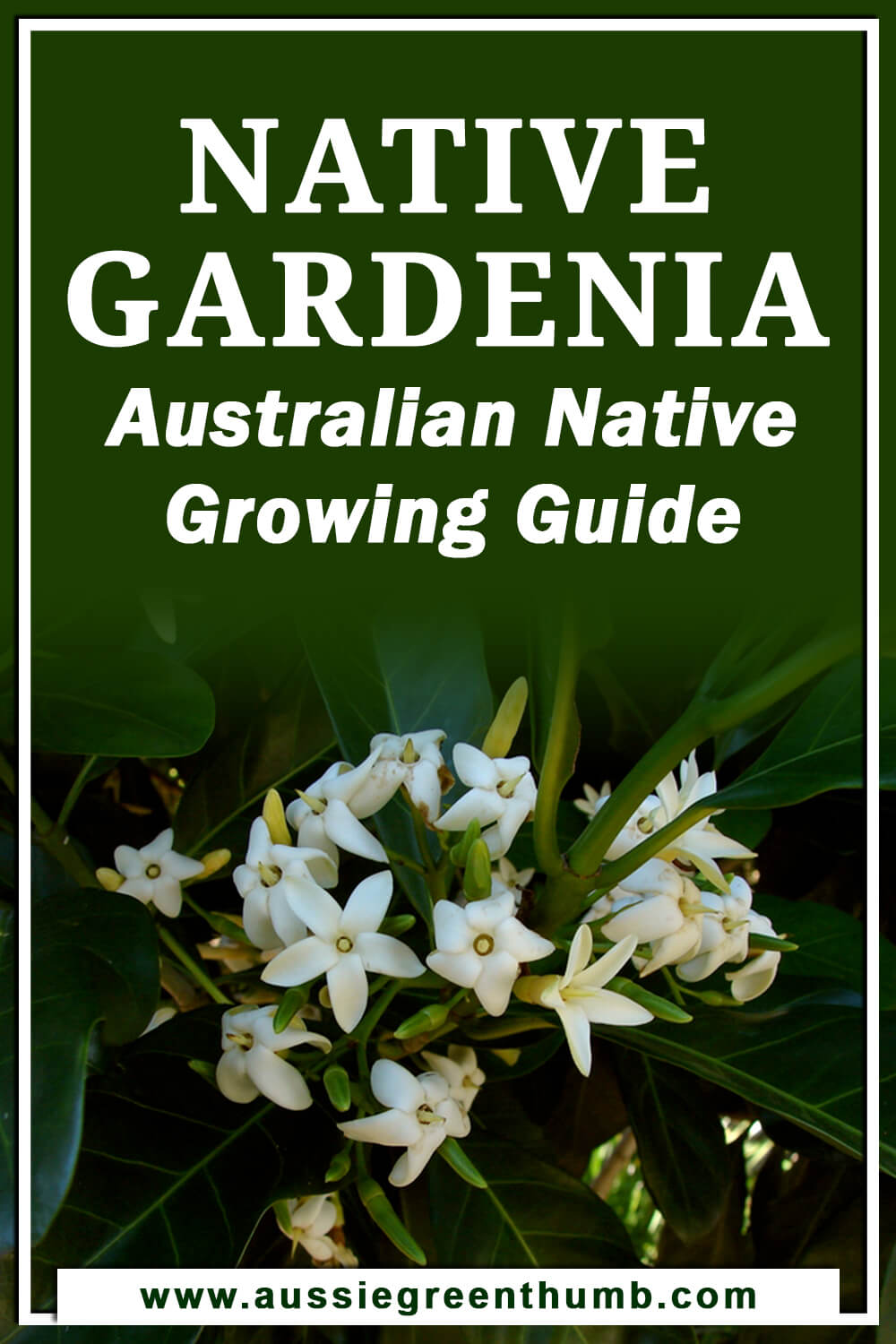
Enjoy Ready to Eat Native Gardenia Fruits in Your Garden
Atractocarpus fitzalanii is the kind of shrub that brings joy to your home and garden. You can enjoy the lovely scent of its flowers, while preparing a dish with its divine fruit, and if you’re patient, can one day enjoy the shade of a native gardenia tree.
They might not be the easiest to grow (they are very hungry plants), but with some love and care (and a side order of liquid feed every few weeks), you’ll have a flowering friend that brings happiness.
Whether your ambition is to create chocolate truffles with the yellow mangosteen fruit (yes this is an actual recipe), or just want a beautiful potted plant on your patio that offers a hint of perfume on the wind, you will enjoy adding the native gardenia to your home.
Published on April 29, 2022 by Nathan Schwartz
Last Updated on January 27, 2025





My Native gardenia has been thriving for 16 years and all of a sudden over the last 2 years it has been basically bare of leaves and fruit. Yellow leaves as minimal new growth ( and trunk seems solid. ) What can I do to bring it back to the magnificent canopy it was? I have 4 other native gardenias in the same area which are fine.
Hi there Susie,
Sorry to hear about your struggling native gardenia. It is quite strange that after such a long life thriving it would now show signs of struggle in its growth and fruiting, especially considering your other gardenias are fine.
The heavily wilting issue in its growth is probably the result of some sort of pest or disease issue that has become more severe over time. Your growing conditions must be ideal considering its already long life in your landscape so that shouldn’t be the issue.
The good news is that it can most likely be saved and restored to its former glory with some extra care. I would start by pruning away a good chunk of the dead or damaged branches and foliage.
This should already stimulate new growth naturally. Then I would consider fertilising your plant about monthly now heading into the warmer months with an organic fertiliser and a bit of compost. Yellowing leaves are usually a clear sign of poor nutrition so this should help.
I would also recommend watering a little more frequently when it’s warm and perhaps adding some organic mulch around the base of the plant to increase the moisture levels. This should also boost the growth potential moving forward.
Another issue could be a lack of adequate soil drainage. The soil around this particular plant may have become overly compacted over the years. Perhaps aerate the surrounding soil to loosen it slightly before watering and feeding.
I’m not sure if you’ve noticed any pests but aphids are a common invader. Perhaps consider treating your plant with an organic insecticidal soap or horticultural oil spray directly onto the foliage. Repeat this at weekly intervals for a month or so to see if the problem is indeed pest related. Be sure to water well after application.
Powdery mildew is also a common fungal disease that attacks gardenias. If you notice any patches of grey spots on the leaves, I would consider using a mild fungicide to clear the infection.
Lastly, proper air circulation is a must for gardenias so by pruning away some of the old branches, you will help to improve the circulation, which is great.
Take your time and slowly introduce these measures over time so we don’t end up shocking your plant too much. I believe that with some time and care, you should be able to restore your native gardenia’s canopy growth and fruiting.
Wishing you the best of luck and happy gardening!
Gary Clarke
We planted 4 native gardenias 2 years ago and they are thriving. After a year 1 of them produced an abundance of fruit (the other 3 didn’t)? And that fruit is STILL green, hard and on the tree… is that normal? The tree appears healthy though, should we just leave the fruit on there? It’s been on the tree for 12 months at least! Would be very grateful for your advice.
Hi there Helen,
Firstly, it is good to note that many fruiting trees do need a few seasons to bear enough fruits for good harvests. Native gardenias are also known to be more high-maintenance than other fruiting specimens so I would say what you’re experiencing is quite normal.
When it comes to establishing these plants in your yard, they do tend to need a decent period of acclimation when they transition from their ideal environments to those offered in your landscape. Each plant could need longer than others.
Here are some of the common reasons why your gardenias may not be flowering and fruiting as much as you would like:
Ideally, native gardenias need good amounts of sunlight, cooler temperatures and good humidity to flower and fruit prolifically. Under or overwatering may also be the cause. I would recommend you prune away the older, browning pods and branches to make room for new, healthy bud growth in the coming seasons.
Stick with a good care routine and I’m sure all of your gardenias will begin producing more flowers and fruits soon. Regarding the green fruits, I would leave the healthiest-looking fruits and discard the others.
I hope this information helps you. Happy gardening!
Gary Clarke
thankyou so much for the information.
am looking to buy 2 small shrubs to plant in pots.
Thanks for a very imformative article. One question, I have one that's been in the ground maybe 5 years. I wish to move it to another location. Am I likely to have much success with this? Do they transplant well?
Regards
Andrea
Hi Andrea,
Thanks for the question.
Unfortunately, gardenias are known to be quite tricky to transplant, especially when dealing with an established gardenia like yours.
They generally do not transplant very well and they tend to respond poorly to root damage. Not to say it’s impossible but if you do choose to move your native gardenia, you may need to be prepared to baby it for several months until it settles in the new location.
Autumn is the preferred time to transplant once the weather is milder and the plant has finished flowering so if you do choose to move yours, I would advise doing it in the next few weeks or so for the best results.
Here is a helpful video for a few tips and tricks when transplanting Australian native trees and shrubs.
Wishing you success with your transplanting!
Gary Clarke
They look lovely. Can this grow in WA Mandurah?
If it’s ok. Where can I get them? Any cutting ?
Hi Lynda,
You should be able to pick one up pretty easily in most garden centres. They’re popular enough these days. If not, try some local nurseries. The only difference in growing native gardenia in QLD (where its form) and WA is that you’ll probably need to give it a good exposed spot with really good sun.
They like decent drainage but regular watering (just make sure the soil doesn’t dry out too much in summer).
Depending on the shape you’re after, you can prune it like any hedge, after flowering, or leave it to grow up into a slightly taller tree. They get to around 8 m tall, but can be pruned into really gorgeous multi-stemmed trees when they’re young, which stay to about 4 m tall at most.
Best regards,
Nathan Schwartz
Hi,
I have just been reading your information on native gardenias. My gorgeous tree is 5 mts tall x 4 mts wide with 2 mts cleared from ground to the first branches.
We have pruned it this way. It shades our front courtyard.The flowers have amazing perfume, however the fruit is brown , never soft inside, and drops to the ground (black in colour) when finished.
It is impossible to cut the fruit. Someone told me there are 2 varieties of the tree. Would you please be able to give me any information on how to develop the riper fruit.
Regards
Jill
Hi Jill,
There are actually around thirty species of Atractocarpus (the scientific name of native gardenia), but the three that are nearly always grown in gardens are Atractocarpus benthamianus, Atractocarpus chartaceus, and Atractocarpus fitzalanii.
You’ve probably got A. fitzalanii, which produces yellow-ish brown fruits that do tend to be very firm, but shouldn’t be as tough as you describe (the other two have quite colourful fruit that is generally more edible so it’s unlikely it’s either of those).
The easiest way to tell is to look at the foliage. If it’s waxy and deep green, with a fairly standard leaf shape, it’s almost definitely A. fitzalanii. A. chartaceus has VERY thin leaves, so is easy to identify, and A. benthamianus has wide, slightly matt leaves and orange fruit with pulp.
How you’ve pruned it is spot on. Make the most of its canopy. Now to (hopefully) help you get those fruits to ripen next year. If they’re dropping off while brown, chances are there’s a problem with moisture of nutrients.
They should ripen past brown, to a yellow-brown by mid to late winter ON THE TREE. That’s the important bit. So, add calcium and magnesium to the soil. The easiest way to do this is to sprinkle fish blood and bone meal around the base of the plant in spring, and again in summer.
It’s a slow release feed that gives all the essential nutrients, but with plenty of accessible calcium too.
Hopefully that works and keeps those unripe fruits attached to the tree for longer!
Good luck, and let us know how you get on.
Best regards,
Nathan Schwartz